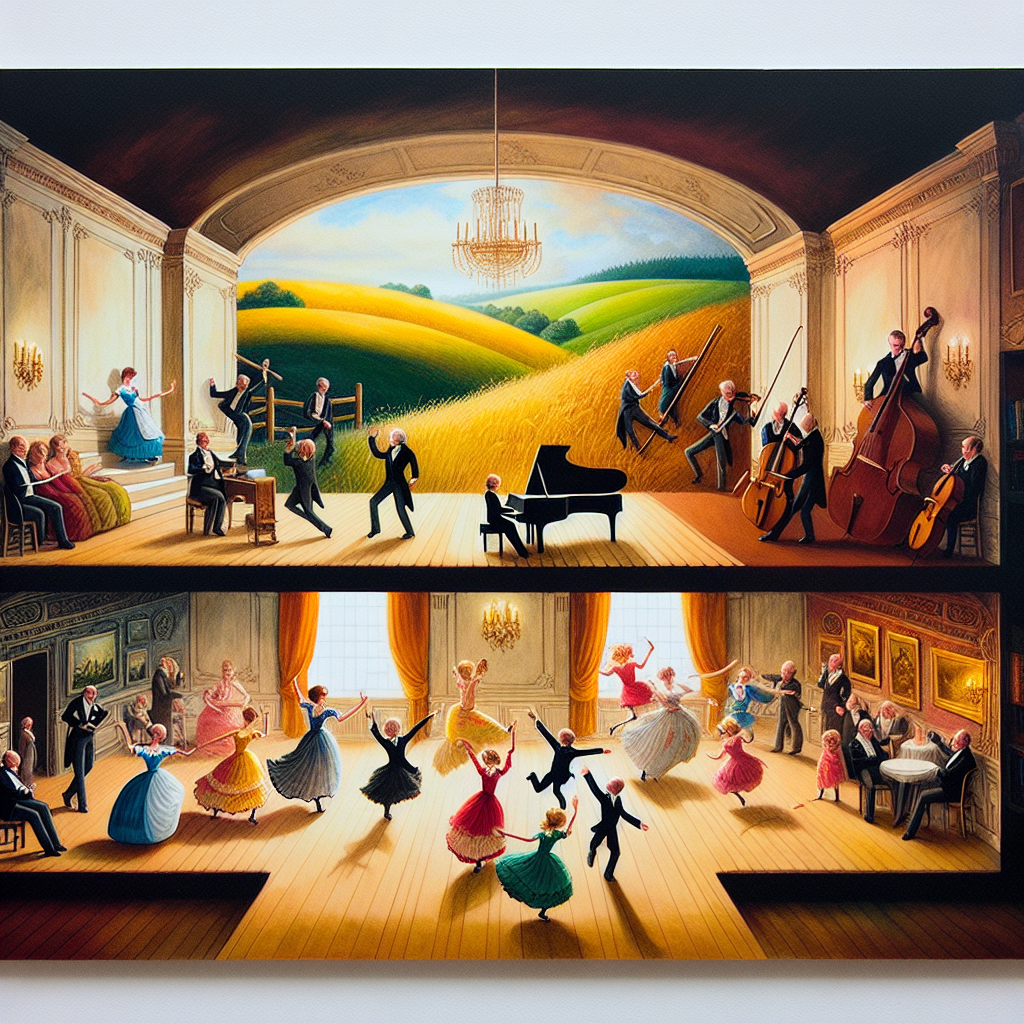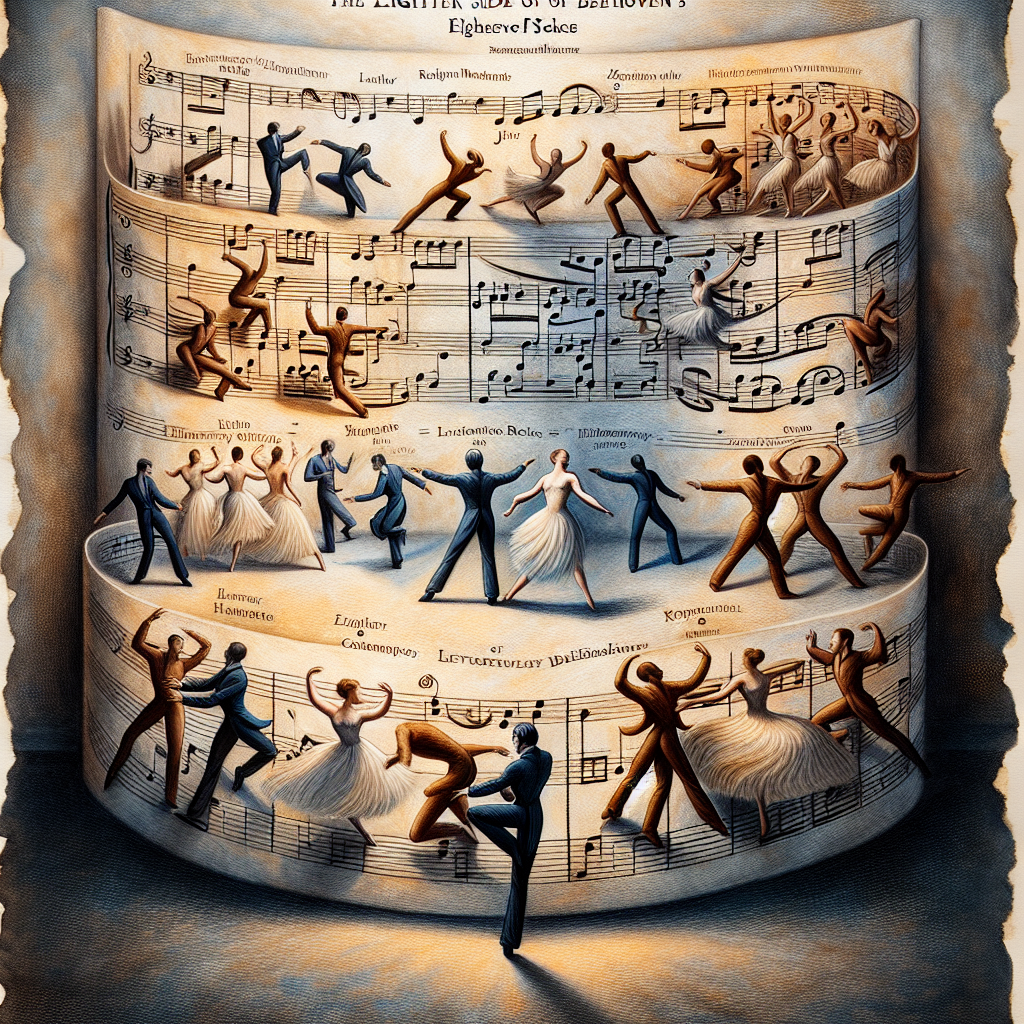
Beethoven’s Dances – Exploring His Lighter Side
Ludwig van Beethoven, a name that has echoed through the annals of classical music history, is often celebrated for his profound symphonies, poignant sonatas, and remarkable concertos. While much attention is lavished upon his monumental works, there exists a lighter, more playful aspect of Beethoven’s oeuvre that is equally deserving of appreciation. Enter Beethoven’s dances, variations, and overtures – a realm where the maestro’s inventiveness and capacity for joy and celebration come to the fore. This article strives to shed light on these often-overlooked gems and offers insights into Beethoven’s more buoyant and animated side.
In his lifetime, Beethoven bridged the Classical and Romantic eras, leaving behind a legacy punctuated by his mastery over various musical forms. However, his contributions aren’t confined to his symphonic and orchestral prowess. Indeed, his dances, variations, and overtures provide an intriguing peek into his multifaceted genius—a side that many might find surprisingly delightful.
Let’s embark on a journey to explore and understand Beethoven’s light-hearted compositions, beginning with an exploration of his various dance forms, transitioning into his innovative variations, and concluding with his captivating overtures. By examining these lesser-known works, we gain an enriched perspective of Beethoven’s musical ingenuity and his ability to infuse joy and eloquence into every note.
Exploring Beethoven’s Dance Music
Dance music may not be the first thing that comes to mind when thinking of Beethoven. However, the dance forms were an essential element of his compositional output, especially during his early and middle periods. These dances were not merely functional pieces meant for social occasions but carried the unmistakable stamp of Beethoven’s creativity and innovation.
One striking example is Beethoven’s “Minuets” and “German Dances.” Minuets were a staple of the Classical period, and Beethoven composed several sets that displayed grace and classical elegance. His Minuets are characterized by their structural balance and charming melodies, revealing a side of Beethoven that was deft at handling small forms with finesse.
German Dances, on the other hand, were a more folk-inspired genre. Beethoven’s German Dances channel the rustic atmosphere of the country dance, presenting lively and infectious rhythms. They reflect his ability to capture the essence of popular music while imparting his unique voice. These dances were often written for social gatherings and embodied the spirit of joy and community.
In addition to these, Beethoven composed several pieces under the title “Contredanses.” These works showcase his playful and spirited approach to dance music. The “Twelve Contredanses” written around 1791-1802, prominently feature catchy melodies and rhythmic vitality, embodying the conviviality of the dance floor. Each piece, though brief and succinct, reveals Beethoven’s command over form and his gift for melodic invention.
Beethoven’s Variations: A Playground of Musical Ideas
When we delve into Beethoven’s variations, we witness an arena where his creativity and experimental spirit truly shine. A variation is a musical form where a theme is presented and then altered in successive statements, allowing the composer to explore a myriad of possibilities within a single melodic idea.
One of Beethoven’s most renowned set of variations is the “Diabelli Variations” (Opus 120). Composed late in his career, these 33 variations on a waltz by Anton Diabelli are a veritable tour de force. Beethoven takes a seemingly simple and mundane waltz and transforms it through an astonishing range of expressions and techniques, turning it into a profound and monumental work. Through these variations, every facet of Beethoven’s compositional prowess—humor, drama, technical mastery, and emotional depth—comes to the fore.
Additionally, Beethoven’s “33 Variations on a Waltz by Diabelli” is considered one of the pinnacles of variation form, alongside Bach’s “Goldberg Variations.” The thematic transformation in each variation showcases how Beethoven turned a straightforward waltz into a canvas for his most imaginative and diverse ideas.
Another significant work in his variation repertoire is “The Eroica Variations” (Opus 35). The theme used here is the same as in the final movement of his “Eroica Symphony” (Third Symphony). These variations exhibit not only Beethoven’s structural ingenuity but also his ability to weave thematic material into complex and multifaceted musical tapestries. Each variation unveils a different layer of Beethoven’s intricate musical thought.

The Art of Beethoven’s Overtures
Beethoven’s overtures are perhaps where his dramatic capabilities are most prominently showcased. Often serving as preludes to theatrical works, his overtures encapsulate the essence of the entire work in a condensed form, brimming with intensity and flair.
One of the most famous examples is the “Egmont Overture” (Opus 84), composed as part of the incidental music for Goethe’s play “Egmont.” This overture, much like the play, contains themes of heroism and struggle. It opens with a dark and brooding introduction, soon giving way to a vigorous and triumphant finale. The “Egmont Overture” is a masterclass in orchestral writing, demonstrating Beethoven’s ability to convey profound narratives in a relatively short span of time.
Likewise, the “Coriolan Overture” (Opus 62) is another testament to Beethoven’s prowess at the overture form. Written for Heinrich Joseph von Collin’s tragedy “Coriolan,” the overture captures the intense inner conflict and tragic fate of the protagonist. The dichotomy between the urgent, aggressive main theme and the lyrical secondary theme illustrates the tension and turmoil central to the narrative.
In addition, Beethoven’s “Leonore Overture No. 3” (Opus 72b), one of the four overtures written for his opera “Fidelio,” stands as a monumental piece in the overture repertoire. Bold and expansive, it encompasses the core themes of the opera including the ideas of enlightenment, justice, and liberty. The interplay of stark proclamation and serene resolution typifies Beethoven’s genius in portraying profound emotional landscapes through orchestral means.
Beethoven’s Legacy in Variations, Dances, and Overtures
Beethoven’s contributions to the genres of dances, variations, and overtures have left an indelible mark on the musical landscape. Through these forms, he demonstrated his versatility and ability to infuse sophistication and innovation even into lighter, more accessible compositions.
Beethoven’s dance music, while less monumental than his symphonies or sonatas, offers a delightful glimpse into his genius with a focus on rhythm, melody, and form. His minstrels, German dances, and contredanses are charming examples of how Beethoven could take conventional forms and elevate them with his unique musical touch.
In the realm of variations, Beethoven’s works stand out as paragons of inventiveness. Whether it’s the transformative “Diabelli Variations” or the structurally complex “Eroica Variations,” Beethoven’s ability to manipulate and reinvent a theme reflects his profound understanding of musical architecture and emotional expression.
As for his overtures, they remain iconic for their powerful and expressive storytelling. Pieces like the “Egmont Overture,” “Coriolan Overture,” and “Leonore Overture No. 3” have cemented their place in the orchestral repertoire, continuing to captivate audiences with their dramatic flair and narrative depth.
Conclusion: A Multifaceted Maestro
While Beethoven is often revered for his symphonies, concertos, and sonatas, his dances, variations, and overtures provide a fuller picture of his creative spirit. These works reveal a composer who was not only a master of form and structure but also possessed a boundless imagination and a keen sense of joy and playfulness.
Exploring Beethoven’s lighter side through his dance compositions unveils the agile and graceful aspects of his music. His ability to craft intricate variations showcases his deftness in transforming simple themes into complex, multifaceted works. And his overtures underscore his dramatic capabilities, encompassing entire narratives within compelling and tightly woven compositions.
By delving into these diverse forms, we enrich our understanding of Beethoven not just as a towering figure in classical music but also as a versatile artist capable of infusing every genre with his distinctive genius. Thus, as we listen to and appreciate Beethoven’s monumental symphonies and sonatas, let us also embrace the elegance, wit, and vivacity of his dances, variations, and overtures—testaments to the lighter yet equally profound dimensions of his artistry.
In sum, Ludwig van Beethoven’s legacy, illuminated through his lighter works, stands as a testament to a multifaceted maestro whose influence continues to resonate across centuries. His dances, variations, and overtures not only entertain and delight but also reveal the boundless scope of his musical vision, affirming why Beethoven remains an enduring beacon in the world of classical music.